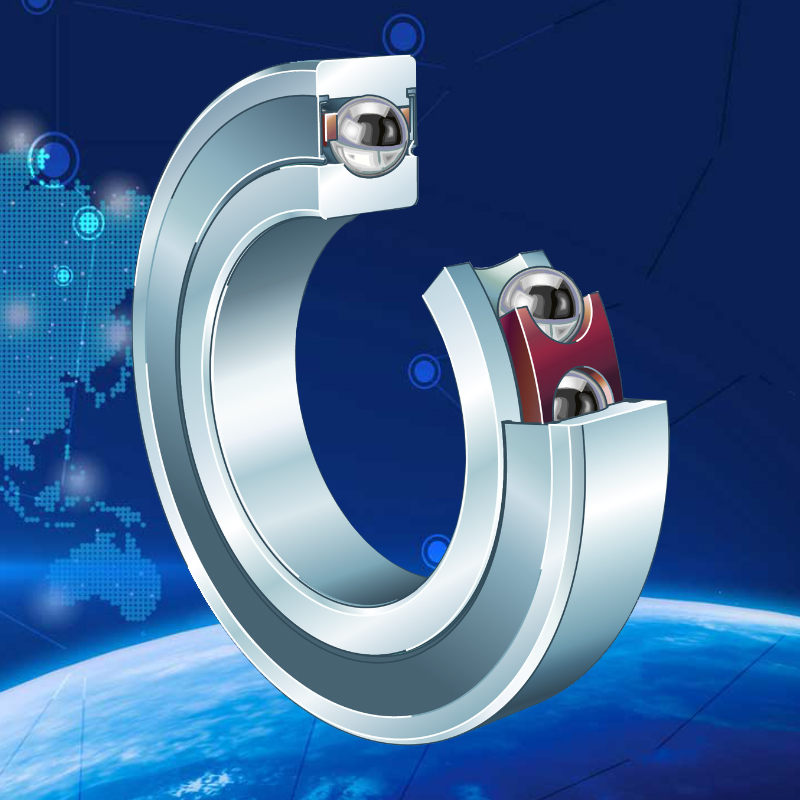SẢN PHẨM
Năng lực R&D sản phẩm hàng đầu

Năng lực R&D sản phẩm hàng đầu

VÒNG BI CẦU TIẾP XÚC GÓC CHẶN MỘT HƯỚNG
Vòng bi tiếp xúc góc đẩy chủ yếu được sử dụng làm giá đỡ trục vít lăn trong máy công cụ. Nó có giá đỡ trục và độ chính xác hành trình cao, cũng như mô men ma sát thấp.
Vòng bi tiếp xúc góc đẩy sử dụng thiết kế không thể tách rời, lồng được gia cố bằng sợi thủy tinh và nylon 66, chứa nhiều bi hơn, góc tiếp xúc 60°, các đặc điểm thiết kế này giúp tăng cường độ cứng dọc trục của vòng bi, do đó có thể thích ứng với việc điều chỉnh hướng trục và hướng kính.
Vòng bi tiếp xúc góc chặn chỉ có thể chịu được một hướng tải trọng dọc trục, nếu tải trọng của một vòng bi không đáp ứng được yêu cầu hoặc cần chịu được hai hướng tải trọng dọc trục thì phải lựa chọn nhóm vòng bi.
Hình dạng nhóm ổ trục
Nhóm ổ trục đã được lắp ráp trước khi xuất xưởng, chỉ cần nhóm ổ trục được cố định và siết chặt trước thì mỗi ổ trục đều có thể đạt được tải trọng định trước và phân bổ tải trọng tốt.
Dấu nhóm ổ trục
Để đảm bảo lắp đặt chính xác nhóm ổ trục, bề mặt của xi lanh ngoài của ổ trục có dấu “V”, và ổ trục
nhóm phải được lắp đặt theo trình tự đánh dấu “V” trong quá trình lắp đặt. Ngoài ra, ký hiệu “V” cũng chỉ ra hướng tác động của tải trọng dọc trục của nhóm ổ trục. Khi chịu tải trọng dọc trục hai chiều, cần xem xét hướng tải trọng dọc trục lớn hơn.
Kích thước
Vòng bi tiếp xúc góc đẩy có sẵn kích thước hệ mét và hệ Anh, kích thước hệ mét thuộc về loạt sản phẩm tiêu chuẩn. Kích thước của nó tuân thủ tiêu chuẩn quốc tế 1S015-1981 và vòng bi có kích thước inch được sản xuất để đáp ứng các yêu cầu đặc biệt. Khách hàng nên chọn loạt hệ mét làm lựa chọn đầu tiên.
Trợ cấp
Bất kỳ cặp đôi nào
Vòng bi tiếp xúc góc đẩy chủ yếu được lắp trên trục vít dẫn theo dạng nhóm. Vòng bi kết hợp tùy ý HRB có thể cung cấp cho bạn sự tiện lợi khi lắp ráp, vòng bi này được cung cấp theo một bộ duy nhất, có thể lắp ráp theo bất kỳ hình thức nào.
Tốc độ giới hạn
Tốc độ giới hạn được liệt kê trong bảng là giá trị đánh giá tốc độ giới hạn của một ổ trục đơn trong điều kiện bôi trơn bằng dầu và mỡ. Đối với nhóm ổ trục, tốc độ giới hạn của một ổ trục đơn được nhân với hệ số sau: hai tổ hợp ổ trục: 0,8; ba nhóm ổ trục: 0,65; bốn nhóm ổ trục: 0,5.
Ma sát
Vòng bi tiếp xúc góc đẩy có đặc điểm là ma sát thấp, mô men ma sát tổng của nhóm vòng bi đạt được bằng cách chồng một vòng bi duy nhất. Nhìn chung, mô men khởi động gấp đôi mô men làm việc.
Độ cứng trục và tải trước
Vòng bi tiếp xúc góc đẩy có độ cứng trục cao, không chỉ được xác định bởi thiết kế cấu trúc bên trong của vòng bi mà còn bởi tải trước khi lắp vòng bi. Tải trước của vòng bi khớp được chia thành ba loại: nhẹ (A), trung bình (B) và nặng (C), và mô-men ma sát khởi động tương ứng cũng được chia thành ba loại. Tải trung bình gấp đôi tải nhẹ, tải thẳng đứng gấp đôi tải trung bình và mô-men ma sát khởi động giống nhau.
Lồng
Vòng bi tiếp xúc góc đẩy HRB có lồng ép phun sợi thủy tinh gia cường nylon 66 cộng với. Thông thường, nhiệt độ cao trong thời gian ngắn sẽ không có tác động xấu, nhiệt độ lồng thích hợp là -40℃-+120℃.
Tải trọng trên nhóm ổ trục
Giá trị tải trọng động và tĩnh định mức cơ bản được đưa ra trong mẫu là cho một ổ trục duy nhất. Đối với nhóm ổ trục, cần phải rõ ràng rằng mỗi ổ trục chỉ có thể chịu tải theo một hướng. Do đó, tổng tải trọng phải được tính bằng số lượng ổ trục chịu tải theo một hướng nhất định. Ví dụ: một cặp ổ trục được sắp xếp lưng vào lưng: chỉ có một ổ trục chịu tải theo một hướng nhất định.
Tra dầu
Góc đẩy theo ổ trục tiếp xúc có thể sử dụng bôi trơn bằng dầu hoặc bôi trơn bằng mỡ, thông thường, bôi trơn bằng mỡ lý tưởng hơn, vì mối nối ổ trục a có thể được đơn giản hóa, yêu cầu bảo trì thấp, chất lượng cao, mỡ chống kiềm là phù hợp nhất, phạm vi sử dụng của nó là -30℃-+110℃, lượng mỡ là 25%-35% không gian hiệu quả trong ổ trục.
Độ chính xác của các thành phần có liên quan
Việc sản xuất vòng bi tiếp xúc góc đẩy có mức độ chính xác cao, nếu độ chính xác của các thành phần liên quan phù hợp với vòng bi thì độ chính xác quay của trục và độ chính xác định vị có thể đáp ứng các yêu cầu cao, do đó dung sai của các thành phần không liên quan nằm trong phạm vi cho phép.
Single direction angular contact thrust ball bearing